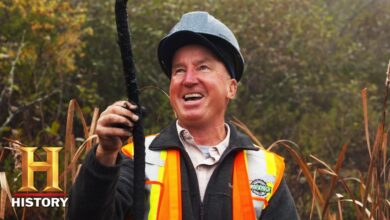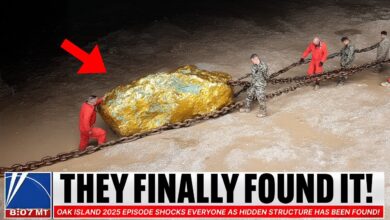The Curse of Oak Island’s Steve Guptill and Terry Matheson Explain!
The Curse of Oak Island's Steve Guptill and Terry Matheson Explain!

One question we always get asked, or we always—people always say—is,
“Why didn’t they drop a camera down there? Why didn’t they drop a camera down there?”
They gotta—so I guess the question is going to be:
What are the parameters for dropping a camera down?
Like who decides, and, you know, you can only drop a camera down if there’s something there to see, obviously.
So we don’t drop a lot of cameras down.
It’s very time-consuming.
So you’ll take already a day, day and a half, B hole,
and then for us to get a camera set up—um, goodness—that’s a couple hours to record it, couple hours.
So you’re taking a day and a half B hole and you’re making it at least two, two and a half.
So that’s the first deterrent from running a camera or the sonar down each hole.
And we typically only run a camera down a hole if we believe that we’re in an open void—like a cave or a tunnel—that we think we might be able to see down, or a shaft.
But even a shaft, you’re limited to the walls.
But really, it’s just time-consuming.
It gives us great information when we can see.
Unfortunately, when we do put a camera down, we run into muddy water,
and so it’s been typically not as successful as, say, the sonar.
The sonar has actually been a pretty cool tool for us to use.
That’s awesome.
And we use that just as frequently—if we’re setting up the camera, run the sonar.
But again, most of these tunnels we hit, we’ve done so many B holes, we know where it projects to.
Most of the shafts, we know where they’re at, right?
And so the only time that we really get into the sonar or camera is if it’s brand new—if we just hit something and we don’t know, we didn’t know that was there.
And so, at this point in time, the camera—the sonar, especially the sonar—is a great tool because if the camera can’t see, that sonar can still give us returns and help us at least map something to give us another target.
So let’s say we’re into a brand new tunnel.
We’ve dropped that sonar down and it’s maybe given us eight feet in either direction.
But that’s eight feet that we didn’t know, and we can put that—Terry and I can put that—in our 3D model, and that gives us a target with the drill.
And so, really, it’s just a tool to help us clarify the next portion of the drill program.
The camera is less significant, as Steve mentioned, than the sonar.
When we get down in an open space—it’s not open—
if you imagine you take a stick and you push it into a mud puddle that’s down three or four inches,
you go to the bottom of that, you move that stick just a hair, and the water just roils up.
And camera work is just out of the question at that point.
So the sonar, as Steve mentioned, is the better tool for sure.
And again, it’s the time-consuming effort that has to go into whether you’re going to do camera or not.
The camera goes down very quickly, and it’s—holy cow—
if we haven’t left it for over a day or a weekend kind of a thing,
of leaving it for, yeah—serendipitously if you hit it late on a Friday or something—
then you come in on Monday and we’ve—that was, I think, what happened with the Paul Troutman tunnel there, the T tunnel.
We looked for years and years there, and then Cory and Mo made a bit of an interpretation,
and the tunnel that Paul had been trying to steer us in the direction of—and was hoping to find—was then located.
And we got some great sonar from that.
I think that the images just blew us away, right Steve?
Yeah, that was the best imagery we ever got returned on the sonar and our camera.
Yeah, yeah—well that’s like the Aladdin’s Cave.
When that, you know, the camera went down there, didn’t see a whole lot,
but then I went down there and it was fantastic—I had no idea.
When, you know, Steve, you’re just describing how long it takes to do the bore hole and then add all that extra time—
you know, we’re thinking a bore hole, yeah, you can put two, three in a day,
but, you know, that’s the reality that we do not see by watching the show.
Same thing—deeper holes are more time—sorry, sorry Jeff—
deeper holes are more time-consuming.
Yeah, if you—as you—your production footage per hour, footage per day, is fairly rapid down to about 100 feet.
You get below 100 feet, then you’re pulling rods a lot longer, you’re spending more time bringing the sample up,
and it just takes a lot more time to get below 150 feet.
And some of our holes, in some years, it’s been discouraging.
We’ve missed because you’re also deviating a little more in those deeper holes.
Yeah, so, so yeah—it’s slow going below 150, and takes you down into the muddy—uh, sorry,
that would take you down into the solution channel, anything below about 150.
[Music]
[Music]
One question we always get asked, or we always—people always say—is,
“Why didn’t they drop a camera down there? Why didn’t they drop a camera down there?”
They gotta—so I guess the question is going to be:
What are the parameters for dropping a camera down?
Like who decides, and, you know, you can only drop a camera down if there’s something there to see, obviously.
So we don’t drop a lot of cameras down.
It’s very time-consuming.
So you’ll take already a day, day and a half, B hole,
and then for us to get a camera set up—um, goodness—that’s a couple hours to record it, couple hours.
So you’re taking a day and a half B hole and you’re making it at least two, two and a half.
So that’s the first deterrent from running a camera or the sonar down each hole.
And we typically only run a camera down a hole if we believe that we’re in an open void—like a cave or a tunnel—that we think we might be able to see down, or a shaft.
But even a shaft, you’re limited to the walls.
But really, it’s just time-consuming.
It gives us great information when we can see.
Unfortunately, when we do put a camera down, we run into muddy water,
and so it’s been typically not as successful as, say, the sonar.
The sonar has actually been a pretty cool tool for us to use.
That’s awesome.
And we use that just as frequently—if we’re setting up the camera, run the sonar.
But again, most of these tunnels we hit, we’ve done so many B holes, we know where it projects to.
Most of the shafts, we know where they’re at, right?
And so the only time that we really get into the sonar or camera is if it’s brand new—if we just hit something and we don’t know, we didn’t know that was there.
And so, at this point in time, the camera—the sonar, especially the sonar—is a great tool because if the camera can’t see, that sonar can still give us returns and help us at least map something to give us another target.
So let’s say we’re into a brand new tunnel.
We’ve dropped that sonar down and it’s maybe given us eight feet in either direction.
But that’s eight feet that we didn’t know, and we can put that—Terry and I can put that—in our 3D model, and that gives us a target with the drill.
And so, really, it’s just a tool to help us clarify the next portion of the drill program.
The camera is less significant, as Steve mentioned, than the sonar.
When we get down in an open space—it’s not open—
if you imagine you take a stick and you push it into a mud puddle that’s down three or four inches,
you go to the bottom of that, you move that stick just a hair, and the water just roils up.
And camera work is just out of the question at that point.
So the sonar, as Steve mentioned, is the better tool for sure.
And again, it’s the time-consuming effort that has to go into whether you’re going to do camera or not.
The camera goes down very quickly, and it’s—holy cow—
if we haven’t left it for over a day or a weekend kind of a thing,
of leaving it for, yeah—serendipitously if you hit it late on a Friday or something—
then you come in on Monday and we’ve—that was, I think, what happened with the Paul Troutman tunnel there, the T tunnel.
We looked for years and years there, and then Cory and Mo made a bit of an interpretation,
and the tunnel that Paul had been trying to steer us in the direction of—and was hoping to find—was then located.
And we got some great sonar from that.
I think that the images just blew us away, right Steve?
Yeah, that was the best imagery we ever got returned on the sonar and our camera.
Yeah, yeah—well that’s like the Aladdin’s Cave.
When that, you know, the camera went down there, didn’t see a whole lot,
but then I went down there and it was fantastic—I had no idea.
When, you know, Steve, you’re just describing how long it takes to do the bore hole and then add all that extra time—
you know, we’re thinking a bore hole, yeah, you can put two, three in a day,
but, you know, that’s the reality that we do not see by watching the show.
Same thing—deeper holes are more time—sorry, sorry Jeff—
deeper holes are more time-consuming.
Yeah, if you—as you—your production footage per hour, footage per day, is fairly rapid down to about 100 feet.
You get below 100 feet, then you’re pulling rods a lot longer, you’re spending more time bringing the sample up,
and it just takes a lot more time to get below 150 feet.
And some of our holes, in some years, it’s been discouraging.
We’ve missed because you’re also deviating a little more in those deeper holes.
Yeah, so, so yeah—it’s slow going below 150, and takes you down into the muddy—uh, sorry,
that would take you down into the solution channel, anything below about 150.
[Music]
[Music]








